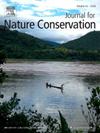Locals’ perceptions of the conservation status and socio-cultural factors determining the consent for cultivation of Vitex doniana Sweet, a threatened species in Burkina Faso
IF 2.2
3区 环境科学与生态学
Q2 BIODIVERSITY CONSERVATION
引用次数: 0
Abstract
Vitex doniana Sweet is a socio-economically important agroforestry species in Africa. However, the species is threatened by overexploitation, the degradation of its natural habitats, and the climate pejoration. Understanding the socio-cultural factors that influence local perceptions of species status and influence decisions about its conservation or cultivation is crucial for developing effective management strategies. Semi-structured individual interviews were conducted with 384 respondents familiar with the species. The questionnaire concerned the socio-cultural profile of respondents, their opinion on the species availability, the local conservation practices, and their willingness to cultivate or to conserve the species in-situ. The results showed that the majority of people (77.72%) perceive a decline in V. doniana populations. This regressive perception varied significantly depending on ethnic group, education level, and main occupation. Overexploitation (34.64%), agriculture (19.79%), vegetation fires (14.06%), and negative effects of climate change (10.01%) were cited as the main causes of the species decline. Despite the species is recognized to be in decline and the causes are known, few conservation strategies were implemented by locals. When cited, their number varied significantly according to ethnic groups and education level. The cited local practices for the conservation of V. doniana included planting (25.65%), raising awareness (20.68%), cutting interdiction (18.23%), and natural assisted regeneration (15.62%). Furthermore, gender, age and education level were the socio-demographic factors that significantly influenced the willingness of people to cultivate V. doniana. These finding prove that successful conservation strategies for the species must consider the sociodemographic dimension in a participatory approach.
当地人对保护状况的看法和社会文化因素决定了他们是否同意种植白荆(Vitex doniana Sweet),这是布基纳法索的一种濒危物种
白荆是非洲重要的社会经济农林业树种。然而,该物种受到过度开发,自然栖息地退化和气候恶化的威胁。了解影响当地对物种状况的看法并影响其保护或培育决策的社会文化因素对于制定有效的管理策略至关重要。对384名熟悉该物种的受访者进行了半结构化的个人访谈。问卷调查内容包括受访者的社会文化概况、对物种可得性的看法、当地的保护措施以及他们在当地培育或保护物种的意愿。结果表明,77.72%的调查对象认为大叶蝉种群数量有所下降。这种退化感知因种族、教育水平和主要职业而有显著差异。过度开发(34.64%)、农业(19.79%)、植被火灾(14.06%)和气候变化的负面影响(10.01%)是导致物种减少的主要原因。尽管该物种被认为在减少,原因也很清楚,但当地人很少实施保护策略。当被引用时,他们的数量因种族和教育水平而有显著差异。被引用的地方保护措施包括种植(25.65%)、提高认识(20.68%)、禁止采伐(18.23%)和自然辅助再生(15.62%)。此外,性别、年龄和受教育程度是显著影响人们种植龙葵意愿的社会人口因素。这些发现证明,成功的物种保护策略必须以参与式的方式考虑社会人口层面。
本文章由计算机程序翻译,如有差异,请以英文原文为准。
求助全文
约1分钟内获得全文
求助全文
来源期刊

Journal for Nature Conservation
环境科学-生态学
CiteScore
3.70
自引率
5.00%
发文量
151
审稿时长
7.9 weeks
期刊介绍:
The Journal for Nature Conservation addresses concepts, methods and techniques for nature conservation. This international and interdisciplinary journal encourages collaboration between scientists and practitioners, including the integration of biodiversity issues with social and economic concepts. Therefore, conceptual, technical and methodological papers, as well as reviews, research papers, and short communications are welcomed from a wide range of disciplines, including theoretical ecology, landscape ecology, restoration ecology, ecological modelling, and others, provided that there is a clear connection and immediate relevance to nature conservation.
Manuscripts without any immediate conservation context, such as inventories, distribution modelling, genetic studies, animal behaviour, plant physiology, will not be considered for this journal; though such data may be useful for conservationists and managers in the future, this is outside of the current scope of the journal.
 求助内容:
求助内容: 应助结果提醒方式:
应助结果提醒方式:


